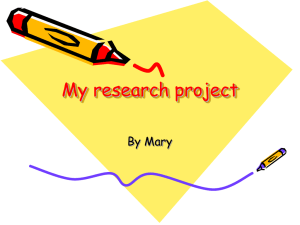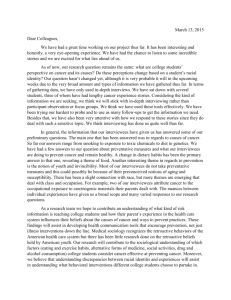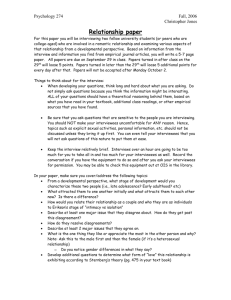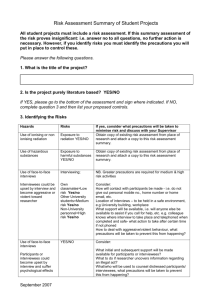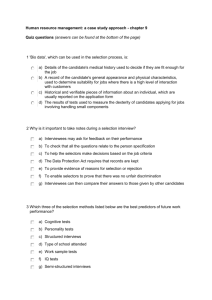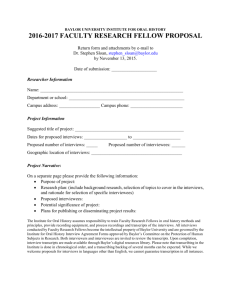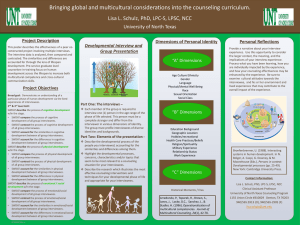February 12, 2015 Gary Magnuson and Project Team
advertisement
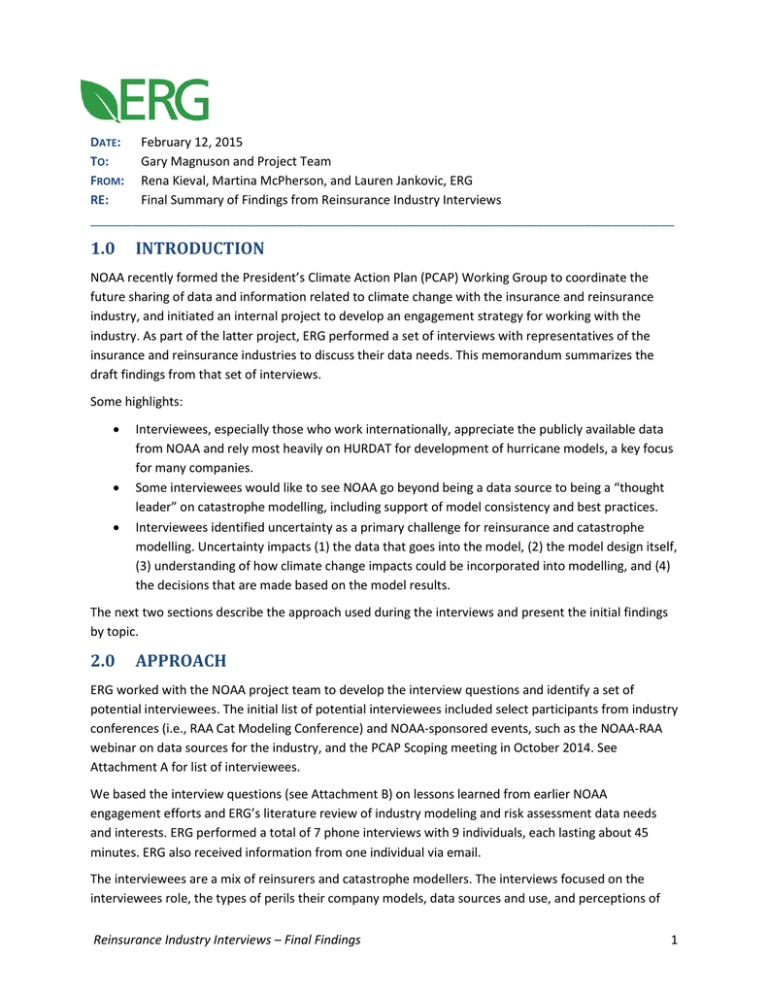
DATE: February 12, 2015 T O: Gary Magnuson and Project Team FROM: Rena Kieval, Martina McPherson, and Lauren Jankovic, ERG RE: Final Summary of Findings from Reinsurance Industry Interviews _____________________________________________________________________________________ 1.0 INTRODUCTION NOAA recently formed the President’s Climate Action Plan (PCAP) Working Group to coordinate the future sharing of data and information related to climate change with the insurance and reinsurance industry, and initiated an internal project to develop an engagement strategy for working with the industry. As part of the latter project, ERG performed a set of interviews with representatives of the insurance and reinsurance industries to discuss their data needs. This memorandum summarizes the draft findings from that set of interviews. Some highlights: Interviewees, especially those who work internationally, appreciate the publicly available data from NOAA and rely most heavily on HURDAT for development of hurricane models, a key focus for many companies. Some interviewees would like to see NOAA go beyond being a data source to being a “thought leader” on catastrophe modelling, including support of model consistency and best practices. Interviewees identified uncertainty as a primary challenge for reinsurance and catastrophe modelling. Uncertainty impacts (1) the data that goes into the model, (2) the model design itself, (3) understanding of how climate change impacts could be incorporated into modelling, and (4) the decisions that are made based on the model results. The next two sections describe the approach used during the interviews and present the initial findings by topic. 2.0 APPROACH ERG worked with the NOAA project team to develop the interview questions and identify a set of potential interviewees. The initial list of potential interviewees included select participants from industry conferences (i.e., RAA Cat Modeling Conference) and NOAA-sponsored events, such as the NOAA-RAA webinar on data sources for the industry, and the PCAP Scoping meeting in October 2014. See Attachment A for list of interviewees. We based the interview questions (see Attachment B) on lessons learned from earlier NOAA engagement efforts and ERG’s literature review of industry modeling and risk assessment data needs and interests. ERG performed a total of 7 phone interviews with 9 individuals, each lasting about 45 minutes. ERG also received information from one individual via email. The interviewees are a mix of reinsurers and catastrophe modellers. The interviews focused on the interviewees role, the types of perils their company models, data sources and use, and perceptions of Reinsurance Industry Interviews – Final Findings 1 challenges facing the industry. The remainder of this memo summarizes the interviewees’ comments on these topics. 3.0 FINDINGS The findings are grouped broadly into several categories: primary customers, model types, data types and access, NOAA data and use, barriers to use, and primary challenges facing the industry. 3.1 PRIMARY CUSTOMERS Interviewees were asked to describe their typical customer of policies, contracts, or modeling software, they include: Primary insurance – from single state mutual insurers to international insurers with billions of dollars in annual premiums. Reinsurance companies and reinsurance brokers Financial marketplace Specialty risk (e.g., public non-profits) Consulting – custom projects for companies that can’t afford a license for the model or software, or organizations with specific questions. Insurance commissioners Global data providers Academics Government – all levels (e.g., federal, state, local) and sectors (e.g., transportation, education) Corporations Regulators and local insurance commissioners Customers use the services for a variety of tasks: 3.2 Primary rate filing with the goal of informing, not setting, insurance pricing. Determine underwriting for a new risk. Determine risk and pricing in reinsurance markets (e.g., evaluate whether to purchase a catastrophe bond). Assess risk to a collection of properties – includes physical assets, buildings to niche markets like offshore gas platforms. Risk management. Exploration of different scenarios (e.g., effect of sea level rise on a U.S. hurricane). MODEL TYPES We asked interviewees about the types of hazards or perils they are primarily interested in improving their risk analysis of, and whether they use purchased catastrophe modeling software or develop inhouse models. While most of the interviewees work for companies with a global focus, their primary focus is on natural hazards and perils in the U.S. Including: Reinsurance Industry Interviews – Final Findings 2 Hurricanes – Interviewees emphasized that this is the most popular model (i.e. “The gold standard”) and is the focus of a lot of attention. The models focus on wind damage but have also started to consider storm surge and rain induced flooding. One interviewee compared the challenge of modeling hurricanes to automobile policies, noting that “it’s more difficult with hurricanes because it is hard to develop stable statistics with only a few instances per year, compared to millions of collisions per year for auto policies.” Severe convective storms – Focusing on straight line wind, hail, and tornadoes. Winter storm – Especially snowfall and freezing risk. Flooding – A few modellers are working on riverine flood, inland flooding, and storm surge (sometimes as part of the Hurricane model). Wildfire – These models tend to focus on wind and fuel sources. Earthquake – These models include damage from ground shaking, sprinkler leakage, and sometimes tsunami. Space weather – Interviewees described this as more of an emerging area of modelling. Any peril – The Oasis modeling platform is designed to model any peril that the user desires to investigate. Most of the interviewees we spoke with (6 out of 8) are developing catastrophe models for their company for internal use or development of software. One interviewee noted that their company both develops their own models and purchases third party software to understand the view of risk in the market. Two interviewees at the same company noted that they purchase models for a variety of perils for primary use, but continue to develop in-house models to evaluate third party models or to cover specific areas that are not covered by licensed models. They also noted that they would like to develop their own models but that it requires a large staff with specific skills to evaluate natural risks and the cost of acquiring this staff is too high. In general, the insurance and reinsurance industry is only concerned with what perils will be occurring within the next year since most policies span one-year periods. When asked about the extent to which the interviewees focus on historical data versus future projections, three interviewees noted that their clients are primarily interested in the short-term. One interviewee noted that they rely on historical data but the models put more weight on recent events. Two interviewees noted that they want to know what will happen in the next year to three years, so the modellers focus on models that characterize the chances of certain conditions occurring in that time frame. This short-term focus informs their approach to incorporating issues related to climate change into their work. One interviewee said that due to regular updates of the models, they are implicitly including incremental changes in climate. Three of the interviewees emphasized that they continue to follow research on climate change; however, there are shorter term oscillations in weather patterns that have a more profound impact over the time frame they are interested in and uncertainty surrounding those is of greater concern than potential short term climate change impacts. One interviewee noted that they provide a “warm sea surface temperature catalogue” as part of their model and let the client decide if they want to use it. Reinsurance Industry Interviews – Final Findings 3 3.3 DATA TYPES AND ACCESS ERG asked interviewees about the key types of data that go into their models and risk analyses, how they usually access the data they need, and how often they access the data. NOAA National Hurricane Center (NHC) HURricane DATabase (HURDAT). A database for all hurricanes in the Atlantic Ocean, Gulf of Mexico and Caribbean Sea since 1851 (although the earliest years of record are not used by modellers). This database is the foundation for all U.S. hurricane models and is required by the Florida Commission for Hurricane Loss Projection for insurers in Florida. The database is trusted by modellers and supported by published literature. Interviewees also use NHC tropical cyclone reports. NOAA Storm Prediction Center (SPC) storm reports and tornado database. Best data source for modelling severe thunderstorms. Interviewees noted that the database is great but they need to make corrections for reporting bias; the database tends to have more observations where there are more people reporting, i.e. more developed areas. Also the database provides individual observation points but modellers have to develop swath information to get wind speed intensity footprint for model. NOAA NHC Sea, Lake, and Overland Surges from Hurricanes (SLOSH) model. This model supports development of storm surge models, some of which are paired with the Hurricane model. NOAA publications and data in general. Interviewees rely on NOAA information for testing and validation of models, monitoring real-time events, and planning future model developments. NOAA Climate Forecast System Reanalysis (CFSR) data through National Centers for Environmental Prediction (NCEP) and National Center for Atmospheric Research (NCAR), and North American Regional Reanalysis (NARR). These data sets are used to inform development of thunderstorm footprints. NOAA National Weather Service (NWS). Surface weather data in general. Interviewees find hourly level input to be valuable. NOAA NWS Radar data. This is an emerging data source for tornados and hail especially. Interviewees note that it can be difficult to work with due to database size and need for specialized knowledge. NOAA National Data Buoy Center. Interviewees sometimes use buoy data and tide information. One interviewee finds it useful but is concerned that there is no single archive that provides latitude and longitude information, and that the user can only access one gage at a time. National Drought Monitor, NOAA, USDA, and University of Nebraska-Lincoln. USDA information on vegetation. Supports modelling of wildfires. HWind. All interviewees who were modellers use this data set and expressed frustration over the recent privatization of the data set. Purchased data. Interviewees sometimes purchased data from private weather networks or conduct private data gathering, particularly during large events. USGS Earthquake and Land Use Cover data. FEMA Storm Surge data. Interagency Fire Center. Reinsurance Industry Interviews – Final Findings 4 U.S. Census Bureau. In general, the interviewees prefer to simply download the data directly from a website or FTP site and appreciate flexibility in data access and formatting. Several interviewees noted that the primary data sets, such as HURDAT, are not excessively large and tend to be quick to download. For larger, specialized data sets (e.g., re-analysis data) interviewees have sent a hard drive to NOAA to receive the data but would also like to access it through CD’s or DVD’s, if possible. Two interviewees commented on the availability of data through geospatial web services and noted that they would prefer to simply access the data itself, but recognize that GIS viewers can be very convenient for quickly reviewing the information or showing something to a client. One interviewee praised the Historical Hurricane Tracks as being very useful for showing things to clients. On the other hand, one interviewee noted that spatial data for certain hazard footprints – flood inundation, tornado swaths, wildfire damage, hail – are difficult to find or nonexistent. After downloading the data, modellers generally process the data with basic review, data cleaning, post processing, and statistical analysis prior to formatting it to suit their specific model. Two interviewees noted that their company does not tend to integrate data into models because they are using the data to perform a cross check of third party models, validate modelling decisions, and make internal adjustments. The timing of data access varies for the modellers, generally they need to access data for two primary tasks: model building (once per year) and during events. For example, from March to August, severe thunderstorm modellers are continuously checking the dataset to look for big storms. For regular model building, the modeller may access the data as often as monthly, or when updates occur, to update the data set and read any notes about the new data. Modellers will also revisit a model after an event that has unique characteristics from a natural hazard perspective to ensure that there models are generating storms with such characteristics. Additionally, two interviewees raised the issue of uncertainty in the data and highlighted its importance to catastrophe modelling. One interviewee commented that uncertainty information is very important for the end user of the data because it affects the “tail” events (i.e., very severe weather) much more than the “mean” events (i.e., average storm), and by extension, the decision making and policy development based on the results of the modelling. Another interviewee put it more directly, observing: “There’s uncertainty around everything, but in insurance it has a cost associated with it.” 3.4 NOAA DATA AND INFORMATION Interviewees described the extent to which they use data and information (e.g., metadata, supporting documentation) from NOAA. The datasets used by the interviewees are laid out in detail above, many of the core data sources are provided by NOAA. As a result, the interviewees find the associated metadata and supporting documentation critically important. Two interviewees noted that they use the metadata for quality assurance on the data set, another interviewee noted that metadata can be critical in areas with time dependent or parametric triggers for catastrophe bonds. Reinsurance Industry Interviews – Final Findings 5 In addition to metadata, interviewees noted that they closely follow bulletins, white papers, and case studies produced by NOAA as well as relevant journal articles (i.e., American Meteorological Society, American Geophysical Union). This type of information is not necessarily applied to current models, but is used to support next steps and anticipate future directions in modelling. 3.5 “NOAA should go around the world and train other weather agencies to be as good as they are.” BARRIERS TO USE We then asked interviewees to describe any barriers to using the data, whether their organization has any internal policies that impact their ability to use the data, and how important it is to access data on mobile platforms. Interviewees face few barriers to use of the data. One interviewee observed that for some perils, like hurricanes, there simply aren’t enough data points for good statistical analysis due to the low number of events per year and the short period of record (around 100 years). Two interviewees commented on the difficulty of catastrophe modelling outside of the U.S. One noted that it can be difficult to transfer U.S. federal data overseas due to public domain and security issues. Some datasets are viewable online, but are not available for download (e.g., The U.S. Army Corp of Engineers considers levee data to have national security implications and restricts access to downloads). The other interviewee observed that for European models, they have to pay to access databases that are not nearly as good as the NOAA data. One interviewee noted that tropical cyclones are so well modeled and studied by the industry that there is relatively less concern about fundamental uncertainty. According to this interviewee, it’s much more difficult to gain access to reliable information on the built environment to determine exposure and vulnerability of assets. When asked if their organization has any internal policies that impact their ability to use the data they need, most interviewees responded that there are policies for protecting client data such as damage claims, and intellectual property but there are no limitations on their use of public data. When asked about access to data through mobile platforms, interviewees made a distinction between themselves and their customers. For the modellers, access to data through mobile platforms is not particularly important. On the other hand, most of the interviewees noted that this is growing in importance for their customers. One interviewee observed that access to catastrophe modelling through more mobile platforms is important for breaking down barriers to broader use of the models. “The availability of data through NOAA is good, we want lots of people to be able to look at risk. But most people can’t because they don’t have the skills or the technology to do so. I would like to see more competition in these models.” 3.6 PRIMARY CHALLENGES FACING INDUSTRY ERG asked interviewees what they think are the primary challenges facing the industry. Several interviewees again raised the issue of uncertainty in the data sources and modelling approaches. One interviewee noted that there could be two catastrophe modeling vendors with equally qualified staff and they could develop loss estimates that Reinsurance Industry Interviews – Final Findings 6 differ by 50 to 100 percent how should they evaluate which vendor is more correct? Another interviewee noted that it is difficult to incorporate climate change due to the amount of uncertainty about what the effects will look like at the scale of the models. This sentiment was echoed by another interviewee who pointed out that the normal level of uncertainty in hurricanes is a bigger driver of results than climate change. Another interviewee was concerned with the amount of uncertainty for each piece of the model, particularly for wind vulnerability functions. Other challenges include: Navigating the intersection of environmental science, insurers, and disaster risk reduction in developing nations; Limits to computing power for modelling of mesoscale models; Filling gaps in client data; Lack of competition in catastrophe modelling; Lack of access for researchers to good models; Limited interoperability between catastrophe modelling platforms; Lack of resources to build in house models that are as credible as third party vendors; and The insurance cycle itself (i.e., fewer natural disasters leads to soft market and questions from clients). 3.7 SUGGESTIONS FOR IMPROVING DATA AND INFORMATION PROVIDED TO INDUSTRY Interviewees also offered suggestions to NOAA related to the data and information used by the reinsurance industry. Become a “thought leader” on modelling of natural hazards. Several interviewees expressed an interest in seeing NOAA go beyond being a data source to be a voice in the discussion of modelling approaches. Interviewees see NOAA as the primary researcher on natural hazards, globally, and think of NOAA as a possible “center for excellence” in the field. One interviewee noted that they would rather ask NOAA experts what they think about an issue rather than having access to “tons of data that you have to build a model to understand.” Another interviewee noted that NOAA could help improve consistency, standards, and best practices in catastrophe modelling. Centralize data sources. A few interviewees raised concerns that some NOAA web sites are difficult to navigate (e.g. NCDC) and that the data sources tend to be in “silos.” Interviewees would like to see more centralization of data sources on natural hazards, including links to related data sources from other federal agencies (e.g., FEMA, USGS), if possible. Continue improving HURDAT. Interviewees rely On HURDAT: heavily on HURDAT for hurricane modeling and are “Keep it well vetted. It is used by a lot very interested in any continued improvements to of industries and they make billions of it; in particular the addition of data such as radius of dollars of decisions based on it.” maximum wind. Two interviewees raised concerns about the way changes are made to HURDAT, noting that NOAA should be aware that changes to it have an impact on the industry and that some modellers may appreciate a more collaborative process to updating the database. One interviewee noted that insurance contracts Reinsurance Industry Interviews – Final Findings 7 4.0 are triggered to do different things if a storm is a hurricane at landfall compared to just a tropical depression. Continue to expand information related to uncertainty. Interviewees highlighted uncertainty as a key challenge facing the reinsurance industry with respect to the use of current models to understand risk, and incorporation of climate change into future models. Additional information about the uncertainty of observations, forecasts, and models is welcome. NEXT STEPS Gather feedback from RAA Conference and incorporate into project going forward. Industry Workshop – highlight some issues worth addressing at the workshop based on interviews. Reinsurance Industry Interviews – Final Findings 8 ATTACHMENT A: INTERVIEWEES Scott Stransky, Manager and Principle Scientist, AIR-Worldwide Carl Hedde, Head of Risk Accumulation, and Mark Bove, Senior Research Meteorologist, both of Munich Re Michael Young, Senior Director of Model Product Management, RMS David Smith, Senior Director of Model Development, and Annes Haseemkunju, Meteorologist, both of Corelogic/Eqecat Dickie Whitaker, Chief Executive, Oasis Loss Modeling Framework Ltd. Megan Linkin, Natural Hazards Expert, Vice President, Swiss Re Rowan Douglas, CO of Capital Farms and Policy Practice, Willis Re Gero Michel, Head of Analytics, Montpelier Reinsurance Industry Interviews – Draft Findings A-1 ATTACHMENT B: INTERVIEW QUESTIONS Reinsurance Industry Interviews – Draft Findings B-1 Draft Interview Questions: Reinsurance Industry Data Needs NOAA is developing a strategy to engage the reinsurance industry and gain a better understanding industry data needs that could be addressed by NOAA data and information products. The purpose of this interview is to gain a better understanding of how different occupations within the insurance and reinsurance industry use data for catastrophe and risk modeling, limitations of currently available data, and new data and information sources that could be useful. 1. Describe your current role in the reinsurance industry? (ask about background, education, training, and current title/position/responsibilities) 2. Describe your typical customer (of policies, contracts, or software, whichever is relevant)? 3. What types of hazards or perils (e.g., hurricanes, earthquakes, severe thunderstorms) are you primarily interested in improving your ability to analyze risk? o Does your work focus on a specific geographic area? o Does your risk analysis and catastrophe modeling integrate multiple perils? o Does climate change, sea level rise, or increases in sea surface temperature inform your analysis of risk? o How much of your focus is on analyzing historical data versus projecting future considerations? 4. Do you use purchased catastrophe models or develop in-house models or a blend of both? Why? 5. What are the key types of data (both hazard and non-hazard) that go into these models and risk analyses? o Where do you get the data from? o What types of information would you like to use in your risk analyses but are unable to use because it is unavailable or inadequate? o What limitations do you encounter in integrating data into catastrophe modeling or risk analysis? 6. How do you usually access the data you need? (data sources, location and format of data) o How often do you successfully access NOAA data to inform catastrophe modeling and risk analysis? o Ideally, how would you like to access data? Do you prefer to access the data as downloadable datasets or as geospatial web services? 7. To what extent do you use data and information from NOAA? o Do you use models or products from NOAA to inform catastrophe risk analysis? How so? o How could NOAA improve access and use of its data and tools? Reinsurance Industry Interviews – Draft Findings B-2 o o Do you use metadata supplied by NOAA to ascertain fitness of use and other data quality parameters? If not, how do you decide if the data supplied is appropriate for the analysis you are conducting? How important is it to have supporting information about the dataset? Are resources such as web sites, technical white papers, case studies, and visualizations of the data of value? 8. How is NOAA Hazard data used in your work? Do you need to manipulate the data before it can be used? o Do you value decision support and related analytical tools or do you just require access to the data to run in your own models and systems? 9. When do you need new or recent NOAA Hazard data? How often do you use data to update models and analyses? 10. What are some of the barriers to using the data you would like to use in your risk analyses? 11. How important to your users is access to data that can be accessed on mobile platforms [Smartphones, tablets]? 12. What do you think are the primary issues or challenges facing the reinsurance industry? Catastrophe modeling? (ask to prioritize most to least important) 13. Does your organization have internal policies (e.g., security, confidentiality) related to accessing or storing data that impacts your ability to acquire the data you need? 14. Are there any other comments or suggestions you would like to make about the data and information NOAA provides to the reinsurance industry? Reinsurance Industry Interviews – Draft Findings B-3
